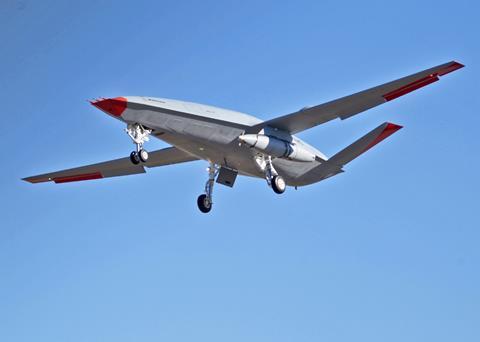US airframer Boeing is continuing to develop its MQ-25 Stingray autonomous refuelling jet, testing software that will allow pilots in other aircraft to control the uncrewed tanker.
Boeing on 1 May said it had successfully tested software that will ultimately enable the pilotless MQ-25 to transfer fuel to crewed US Navy (USN) fighters, including Boeing F/A-18E/F Super Hornets and Lockheed Martin F-35Cs.
Evaluated in a simulator environment, Boeing says its MQ-25 software allowed an F/A-18 pilot to command an unmanned MQ-25 to release its refuelling drogue and begin transferring fuel to the Super Hornet. The link between the aircraft was accomplished using existing communication systems.
This represents a significant advancement in capability for the MQ-25 platform, which previously could not be controlled by a pilot aloft.
“MQ-25 is designed to typically receive commands from air vehicle pilots on an aircraft carrier,” notes Alex Ewing, Boeing’s lead for F/A-18 new product development. “This software will add a second option, enabling pilots to initiate commands right from their cockpit.”

Boeing says the proprietary software will significantly reduce the time it takes for an F/A-18 to communicate with an MQ-25, giving pilots greater flexibility in refuelling from longer distances.
Juan Cajigas, director of Boeing’s MQ-25 programme, says giving a single pilot the ability to control both aircraft involved in the aerial refuelling process is a significant advancement toward the goal of teaming crewed fighters with unmanned support aircraft.
“To be able to direct the activities via a single pilot, safely and efficiently, is a major step forward in aerial refuelling technology,” he notes.
Boeing has already demonstrated the ability of the MQ-25 to top-up three carrier-based aircraft: F/A-18s, F-35Cs and Northrop Grumman E-2D Hawkeyes. This was accomplished using a company-owned demonstrator aircraft called T1.

That aircraft also underwent deck handling trials aboard the USS George HW Bush in 2021.
Now, Boeing is developing an operational version of the Stingray for the navy, which plans to acquire 76 of the uncrewed jets, according to fiscal year 2025 budget documents. At least 67 of those will be operational MQ-25s to support USN carrier air wings.
Boeing delivered the first MQ-25 example – a static test article – to the navy in February.
Under the latest schedule, the navy plans to reach initial operational capability with the MQ-25 fleet in the second half of 2026 – with 13 aircraft delivered.
The MQ-25 represents the navy’s first operational carrier-based unmanned air system, capable of launching and recovering in the same manner as the service’s crewed fighters. It does not require a remote pilot, instead using advanced flight control algorithms and planning software to execute missions and return to the carrier autonomously.
MQ-25s will take over the job of refuelling fighter aircraft at sea – a role currently filled by F/A-18 Super Hornets, which are reassigned from combat duty to act as ad hoc tankers.
The navy says the addition of the MQ-25’s tanker capability will help mitigate a shortage of available combat aircraft and reduce fatigue on the service’s Super Hornet airframes, extending the operational lifetime of the multi-role strike fighters.































